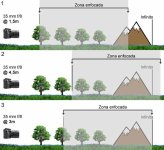I checked that site against the instruction sheet charts that came with my 28 and my 105...web based computer is way off on DOF compared to Nikon literature...so it doesn't work with Nikkor primes...
I could be wrong but I'm pretty sure DX increases the DOF...
Marcel???
OK...I am wrong about this calculator...last night I had selected the D5000 with 28mm lens and was looking at Nikon literature for the 28 on 35mm film...Now when you plug in 35mm film, 28mm lens, and focused distance of 15' the calculator says 6.27' to infinity which is what the Nikon brochure says so it is correct so my statement above is wrong. Now that is full frame 35mm film. Interestingly when you plug in D5000, 28mm lens, and focused distance of 15' the computer says 7.78 - 206.5 so the DX is changing something although it seems to be a very minor difference. It appears to be a decrease in DOF does that sound right???

